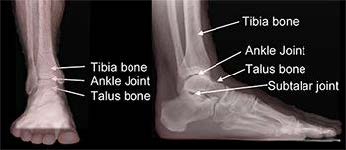Lapidus Procedure
The Lapidus procedure is a surgical procedure used to treat a bunion deformity, also known as hallux valgus. It involves fusing the joint between the first metatarsal bone and one of the small bones in your midfoot called the medial cuneiform. Surgery includes removing the cartilage surfaces from both bones, correcting the angular deformity, then placing hardware (screws and often a small plate) to allow the two bones to grow together, or fuse.
Your foot and ankle orthopedic surgeon may perform this procedure to correct a bunion deformity with a very large angle, or when there is increased mobility through the tarsometatarsal (TMT) joint. When the TMT joint has too much looseness or movement, the condition is known as hypermobility or instability. When this joint becomes hypermobile, the first metatarsal moves too far in one direction and the big toe compensates by moving too much in the other direction. When this happens, a bunion can develop.
The goal of the Lapidus procedure is to surgically treat hallux valgus that is caused by first TMT joint hypermobility. When the first TMT joint is fused, the first metatarsal will not move abnormally. This will allow the first toe to stay straight and decrease the risk of the bunion coming back.
Symptoms
Signs surgery may be needed include:
- A painful bunion on the inner part of the big toe. Typically, this bump causes pain when it rubs the inside of a shoe.
- Pain and/or hypermobility at the first TMT joint.
- Difficulties wearing shoes. When patients have a severe enough bunion due to first TMT joint hypermobility, the foot can be so wide that it is difficult to find shoes that fit.
- Pain that doesn’t improve with non-surgical treatments such as wearing shoes with a wider toe box.
Treatment
The Lapidus procedure is an outpatient procedure, meaning the patient can go home the same day as surgery. Surgery is performed under general anesthesia so the patient is fully asleep or a nerve block is used.
Specific Technique
The Lapidus procedure often is one part of bunion correction surgery. Once the large bony prominence near the big toe is removed, attention is turned to the TMT joint. After the cartilage surfaces of each bone are removed, the alignment is corrected, and the bones are compressed together with hardware. This may be screws or a combination of a plate with screws.
Once the Lapidus is completed, an additional procedure may be necessary to complete the correction of the bunion deformity.
Recovery
Patients typically are immobilized in a splint or boot for the first two weeks after surgery to allow for the incisions to heal. They often are restricted from putting full weight on the foot.
Around six weeks after surgery, patients progress to full weightbearing in either a boot or post-op shoe, then slowly transition to regular shoes a few weeks later.
Some residual swelling and discomfort is normal up to a year after surgery. Most patients are able to return to normal activities with minimal pain and/or problems by four to six months after the surgery.
FAQs
By making the bones grow together, does that affect my ability to walk or run?
A successful Lapidus procedure should allow patients to walk or run with minimal problems or pain once they are fully recovered.
Why do I need to be non-weightbearing for so long?
Patients are asked to limit their weight bearing for several weeks in order to prevent movement between the first metatarsal and medial cuneiform bones that are trying to fuse together. If there is too much motion between the bones, it can take longer for them to heal. Typically, bones take 6-8 weeks to heal, so patients must limit weight bearing during that time.
What if my bones do not heal together?
When bones do not heal together the condition is called a nonunion. Patients who are diabetic or smoke are at higher risk for having this problem. This can also happen if patients put too much weight on the foot before the bones have a chance to fuse together. The most common symptom of a nonunion is continued pain after surgery. X-rays may show broken hardware, which suggests that there is still movement at the fused joint. Most nonunions need further surgery to achieve healing.

